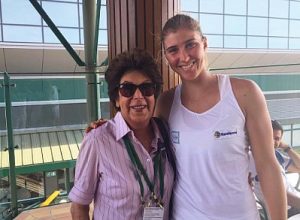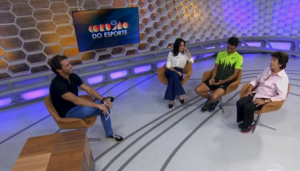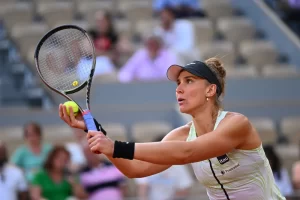
July 2017: Bia Haddad Maia (right), playing her first Grand Slam, collected fond memories at Wimbledon by making two singles matches and the last 16 in doubles (alongside Croatian Ana Konjuh) and then she met up with the biggest Brazilian player of all time, Maria Esther Bueno, posting a photo of herself alongside the legendary tennis player: “Look who I found! It’s been 58 years since Maria Esther Bueno won her first title here!“
In the week in which Maria Esther Bueno passed away 5 years ago, another São Paulo native was making headlines at the French Open in Paris, as Beatriz Haddad Maia made it into the semi-finals, the first Brazilian since the legendary 19-times Grand Slam champion reached the Last 4 at Roland Garros in 1966.
Maria Esther met Bia at Wimbledon in 2017, when she was already struggling with her health, and said what a genuinely nice person she is, and, it seems, Haddad Maia reciprocates because she has been telling everyone who wants to listen in Paris what an inspiration both Bueno and Guga Kuerten have been to her.
Haddad Maia already made history when she arrived in the 4th-round, emulating Patrica Medrado in 1979, and then she made the quarter-finals some 55 years after Bueno last did so at the US Open in 1968.
Haddad Maia already made history when she arrived in the 4th-round, emulating Patrica Medrado in 1979, and then she made the quarter-finals some 55 years after Bueno last did so at the US Open in 1968.
She also did it the hard way, coming through 4 consecutive 3-set matches to get to the semi-finals, amounting to nearly 13 hours on the match court, and dropping the first set in 3 of them to become the first Brazilian to go this deep in Paris since Kuerten in 2001, the year he won the last of his three Roland Garros titles.
On the way she accounted for Ekaterina Alexandrova, Sara Sorribes Tormo and Ons Jabeur before taking on Iga Swiatek, the top seed and World No 1, on Thursday, in the semi-finals.
Bueno, a 7-time major singles winner, who was a Roland-Garros doubles champion in 1960 and the singles finalist in 1964, reached at least the quarter-finals in the first 3 Grand Slams of the Open Era in 1968, but despite her success, Brazil had failed to produce another top-level female player until Haddad Maia’s emergence.
“She’s a person who inspired us for a lot of years,” said Haddad Maia of Bueno. “She was a very powerful woman, as well.”
The 27 year-old added that Bueno ‘inspires me every day’ and hopes her own deeds are sparking hope in young girls in South America, explaining that there are few high-tier WTA tournaments in Brazil, and the long distance required to compete regularly against elite players is a challenge for those coming up through the ranks in tennis.
According to former Brazilian pro Andre Sa, Haddad Maia’s performance comes as no surprise, and he believes she has the game to beat anybody and become a Top 10 player, which could well come as soon as next week.

February 2015: Chat show host Flavio Canto with Fernanda Vasconcellos, André Sá and Maria Esther Bueno
He told ausopen.com that her profile in Brazil is rapidly expanding, and thinks she has the potential to positively influence future generations.
“It’s massive,” said Sa, a Wimbledon quarter-finalist in 2002. “I just saw now she was on the front page of the biggest newspaper in Brazil. A huge photo.
“It’s a reference that the kids need. It’s the same thing that when Guga [Kuerten] was playing well here… It makes a big difference to have someone having those kind of results, because it makes you believe you can as well.
“Now the same thing; all kinds of little girls are definitely going to start playing in Brazil, seeing what she’s doing here and what she’s accomplished.
“Not only that, but she’s a great person. Very easy going, accessible. She’s really nice. The family’s nice. She knows her role as a role model and as an athlete, so she’s always available to the kids, she’s always being nice to fans.
“She’s a complete package.”
Sa met Haddad Maia when she was a young teenager and attended an academy owned by Kuerten’s then-coach Larri Passos, near Kuerten’s home-town of Florianopolis in the south of Brazil.
“She really stood out,” Sa recalled of Haddad Maia. “She was already practising with the pros, the women’s pros. And she was really tall; she was a big girl and very strong. You could tell she had a different talent from everybody else.”
The left-hander, though, has come through and overcome tough times, with a drugs ban interspersed with 4 separate surgeries making her rise up the rankings all the more remarkable.
Her run in Paris came almost 3 years after she returned to the tour with a lowly world ranking of No 1,342, having spent 10 months suspended after testing positive in 2019 for two banned anabolic substances, ironically in Paris while playing in the qualifying competition.
The ITF, though, accepted that she ‘bore no significant fault or negligence for her violation’ on appeal, after she blamed contaminated supplements.
Her first surgery came on her shoulder in 2015, followed by 2 operations on her back in 2018 and, soon after her come-back from her suspension in 2020, she needed surgery on her hand.
“I think four surgeries are not easy to come back from,” Haddad Maia said. “I had tough moments in my career. I had two bones that I broke in the back and the shoulder. For the body I had to stop six or seven times in my career for months and start again.
“I was also one year out from the tour [for her drugs ban], so it’s not easy to keep the level and improve the tennis when you are always coming back.

Bia Haddad Maia pushed World No 1 Iga Swiatek hard in the semi-finals of the French Open but lost in straight sets, 6-2 7-6(7) after 2 hours and 9 minutes at Roland Garros [Photo: © Philippe Montigny/FFT]
Ranked as low as 88 in January, Haddad Maia went on to crack the Top 15 after winning more than 50 matches, while her biggest successes included winning her first two WTA titles at back-to-back grass-court events in Nottingham and Birmingham last year, as well as reaching the WTA 1000 final in Toronto, a week during which she stunned Swiatek.
Until this fortnight, though, the World No 14 had never gone beyond the 2nd-round at a major.
Haddad Maia’s fitness was key in getting her through this fortnight, winning 4 straight matches from a set down, including upsetting the favoured 7th-seeded Jabeur, 3-6 7-6(5) 6-1, after 2 hours and 29 minutes, and bringing her total time on court to 12 hours, 55 minutes, while her semi-final opponent, Swiatek, had only played for 5 hours and 32 minutes.
“I was prepared for the game,” she said of Jabeur. “I knew that it would be very hard. It’s not easy to be a set down against Jabeur, and she was playing well. So when the match was done, I just looked to my team and said, ‘We made it’.
“I think it was one of the biggest and special wins for me, also because Jabeur is a player that I respect a lot.
“It’s very tough to come and go for it because one thing is to win a set, one thing is to have 5-3 and serve, and one thing is to go and win the match.
“I was very proud, and I think my face showed that, I think, hard working, it works sometimes.”
The oldest of the 4 semi-finalists, Haddad Maia’s run at Roland Garros was brought to an end by Swiatek, 6-2 7-6(7), on Thursday, but she pushed the 22-year old Pole hard.
After failing to extend her remarkable run to reach the final, Haddad Maia left Roland Garros with a smile.“Our first goal was to go to the third round,” she said. “We worked very hard, and me and my team deserve and need to be very proud of ourselves, because it’s not easy to be in this stage.
“I think this match and this week will bring me a lot of things to improve, things that we learn to build our game, our mentality.”
Although she improved to 12-0 in sets at the event with her 2-hour, 9-minute win, Swiatek came the closest she has come to being pushed the distance by Haddad Maia.
“She’s really using the fact that she’s a lefty,” Swiatek said. “She’s really using her spin on the serve. It’s just, tactically, a little bit different.
“You always have to, kind of, address and switch most of the things that you do on court because she’s a lefty. I just knew that I can really use my power on clay, and even make it physical if I need to.”
As Haddad Maia rests before transitioning to grass, Bueno remains the last Brazilian woman to reach the final in Paris when she lost to Margaret Court, 5-7 6-1 6-2, in 1964.

